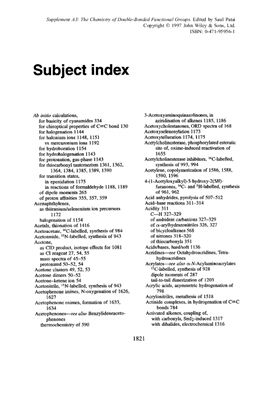Edited by Saul Patai. - 1997 John Wiley & Sons, Ltd. – 1858 p
The first supplementary volume dealing with the chemistry of double-bonded functional groups was published in 1977 and contained thirteen chapters on C=C, C=O, C=N and N=N groups. The second supplementary volume was published in 1989 with eighteen chapters, some of them ‘integrative’ ones, i.e. giving a unified treatment of several doublebonded groups together
I am happy to present now Supplementary A, Volume 3 including again several ‘integrative’ chapters
The literature coverage in most chapters is up to the end of 1994 and in many cases
up to the middle of 1995 or later.
Heteropolar double bonds
Mass spectra of double-bonded groups
Electronic effects of groups containing carbon carbon or carbon oxygen double bonds
The chiroptical properties of the carbon carbon double bond
Chiroptical properties of compounds containing CDO groups
Dipole moments of compounds containing double bonds
Acidity, basicity and H-bonding of double-bonded functional groups: Nitrones, nitriles and thiocarbonyls
Complex formation involving compounds with double-bonded groups
Liquid crystals with X=Y groups
Pyrolysis involving compounds with C=C, C=N and C=O double bonds
Thermochemistry of olefins, carbonyl compounds and imines
The electrochemistry of the C=C, C=O and C=N groups
Photochemistry of compounds containing C=C double bonds
Some synthetic uses of double-bonded functional groups
Hydrogenation of compounds containing C=C, C=O and C=N bonds
Heterogeneous catalytic hydrogenation
Syntheses and uses of isotopically labelled compounds containing C=C, C=O or C=N groups
Nucleophilic attack on compounds containing C=C, C=O or C=N groups
Electrophilic additions to double bonds
Epoxidation of CDX double bonds
Strained olefins
Radical anions and radical cations derived from compounds containing C=C, C=O or C=N groups
The thiocarbonyl group
Advances in the metathesis of olefins
Biological activity of organic compounds elicited by the introduction of double bonds
N-Oxidative transformations of C=N groups as means of toxification and detoxification
The first supplementary volume dealing with the chemistry of double-bonded functional groups was published in 1977 and contained thirteen chapters on C=C, C=O, C=N and N=N groups. The second supplementary volume was published in 1989 with eighteen chapters, some of them ‘integrative’ ones, i.e. giving a unified treatment of several doublebonded groups together
I am happy to present now Supplementary A, Volume 3 including again several ‘integrative’ chapters
The literature coverage in most chapters is up to the end of 1994 and in many cases
up to the middle of 1995 or later.
Heteropolar double bonds
Mass spectra of double-bonded groups
Electronic effects of groups containing carbon carbon or carbon oxygen double bonds
The chiroptical properties of the carbon carbon double bond
Chiroptical properties of compounds containing CDO groups
Dipole moments of compounds containing double bonds
Acidity, basicity and H-bonding of double-bonded functional groups: Nitrones, nitriles and thiocarbonyls
Complex formation involving compounds with double-bonded groups
Liquid crystals with X=Y groups
Pyrolysis involving compounds with C=C, C=N and C=O double bonds
Thermochemistry of olefins, carbonyl compounds and imines
The electrochemistry of the C=C, C=O and C=N groups
Photochemistry of compounds containing C=C double bonds
Some synthetic uses of double-bonded functional groups
Hydrogenation of compounds containing C=C, C=O and C=N bonds
Heterogeneous catalytic hydrogenation
Syntheses and uses of isotopically labelled compounds containing C=C, C=O or C=N groups
Nucleophilic attack on compounds containing C=C, C=O or C=N groups
Electrophilic additions to double bonds
Epoxidation of CDX double bonds
Strained olefins
Radical anions and radical cations derived from compounds containing C=C, C=O or C=N groups
The thiocarbonyl group
Advances in the metathesis of olefins
Biological activity of organic compounds elicited by the introduction of double bonds
N-Oxidative transformations of C=N groups as means of toxification and detoxification

